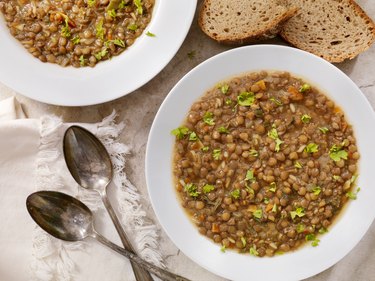
Following a starch-free diet and consuming starch-free foods is a popular choice for those looking to reduce their intake of carbohydrates. Additionally, no-starch diet results may include weight loss or improvements in other medical conditions.
Tip
Although high in carbohydrates, starch can also fuel the body with energy and should be included in a healthy diet.
Video of the Day
The Function of Starch
Starch is a type of complex carbohydrate found in a wide range of foods, including potatoes and whole grains. Starch is made of many sugar units bonded together and occurs naturally in vegetables, grains, cooked dry beans and peas. Starch breaks down into glucose in your body, providing a more gradual energy source for your bodily processes than do simple carbohydrates, such as refined sugar.
Video of the Day
Carbohydrates, such as starches, provide the majority of fuel for your body, so it makes up a significant part of your caloric intake. A 2014 study published in Critical Reviews in Food Science and Nutrition suggests that resistant starch may promote weight loss and/or maintenance by increasing the thermic effect of food thereby increasing total energy expenditure.
Another study published in April 2015 in the Journal of Obesity & Weight Loss Therapy explored and determined that following a low-starch/low-dairy diet resulted in weight loss, increased insulin sensitivity and reduced testosterone in women with Polycystic Ovary Syndrome.
Follow a Starch-Free Diet
The Mayo Clinic says while people often avoid carbohydrates fearing weight gain, there is a reason to include carbohydrates in your diet. Carbohydrates offer numerous health benefits and are needed by the body for optimum function. There are ways to choose and include healthy carbohydrates in your daily routine.
Choose the right grains when eating a low-carb diet. Opt to emphasize high-fiber fruits and vegetables without added sugar. Whole fruits and vegetables can help you feel fuller on fewer calories. Choose whole grains over refined grains that are stripped of their nutrients and fiber. Limit the consumption of foods with added sugar.
Read more: List of Foods With No Starch or Sugar
Other Starch Options
Opt for "better-for-you" starchy foods such as low-fat, minimally processed starchy foods over refined starches. This will help control your caloric intake and may increase nutritional values in your meals, says the Centers for Disease Control and Prevention (CDC).
There are starchy vegetables that act as fuel for the body. Healthy starchy vegetables, legumes and grains include peas, corn, whole grains, potatoes, wheat, parsnips, pumpkin, squash, yams, sweet potatoes, pinto beans, garbanzo beans, lentils, lima beans and other dried beans. High-fiber foods such as vegetables, beans and legumes can also help counteract the fast digestion of starch.
Legumes — which include beans, peas and lentils — are among the most versatile and nutritious foods available. They are typically low in fat and high in folate, potassium, iron and magnesium, and they contain beneficial fats and fiber. Legumes are a good source of protein and can be a healthy substitute for meat, which has more saturated fat and cholesterol.
- NCBI: "Resistant Starch and Energy Balance: Impact on Weight Loss and Maintenance"
- NCBI: "Low Starch/Low Dairy Diet Results in Successful Treatment of Obesity and Co-Morbidities Linked to Polycystic Ovary Syndrome"
- Mayo Clinic: "Carbohydrates: How Carbs fit Into a Healthy Diet"
- Centers for Disease Control and Prevention: "Participant Guide Carbs"
Was this article helpful?
150 Characters Max
0/150
Thank you for sharing!
Thank you for your feedback!